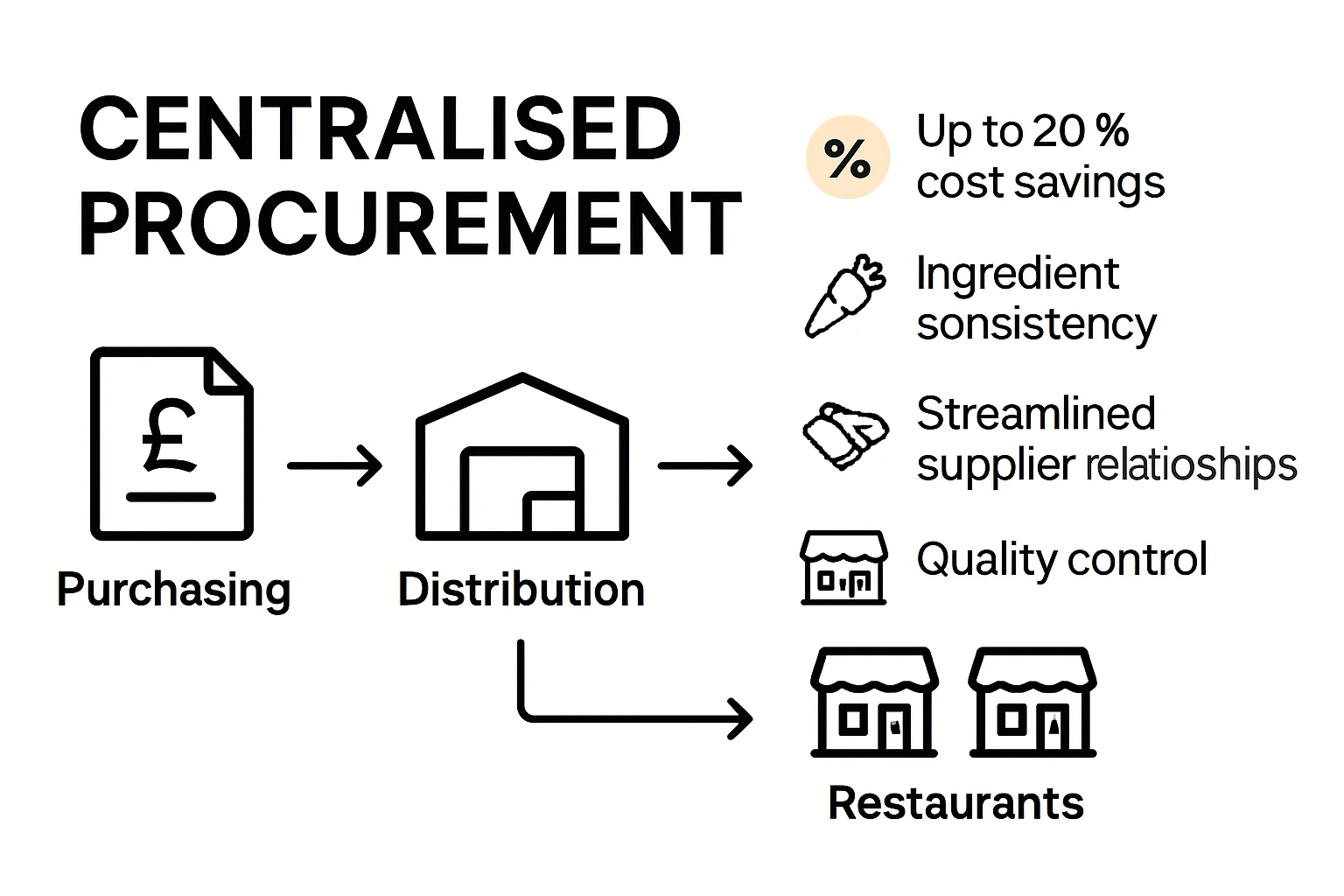Managing a restaurant is tough enough, but running a group of restaurants takes complexity to a whole new level. Hospitality leaders face challenges that multiply with every new location, from staff consistency headaches to supply chain puzzles. Yet, despite these hurdles, some groups achieve remarkable uniformity and performance, with centralised procurement saving up to 20 percent on supply costs across multiple sites. The secret is not stricter control but smarter, adaptable systems that give every restaurant its own local edge while keeping the group marching to the same beat.
Quick summary
Takeaway | Explanation |
|---|---|
Embrace advanced technologies for efficiency | Implement integrated management systems to improve operational workflows from inventory to customer relations. |
Standardise training for consistency | Develop comprehensive training programmes to ensure every location provides the same level of service and quality. |
Centralise management for streamlined operations | Use central management systems to enable real-time data sharing and performance tracking across multiple locations. |
Foster strong leadership and team cohesion | Focus on transformational leadership to inspire employees and cultivate a strong, unified corporate culture across all venues. |
Prioritise procurement and supply chain optimisation | Centralised procurement strategies lead to better pricing, ingredient consistency, and operational efficiency across the group. |
Key challenges in managing large restaurant groups
Managing large restaurant groups presents a complex landscape of operational, technological, and human resource challenges that demand strategic and adaptive approaches. Unlike smaller establishments, multi-location restaurant operations require sophisticated systems and nuanced management techniques to maintain consistency, quality, and profitability. To clarify the main challenges faced by large restaurant groups, the table below summarises the three key challenge areas, their descriptions and examples as discussed in the article.
Technological integration and scalability
Technological challenges emerge as restaurant groups expand. According to industry insights on restaurant challenges, adapting to changing consumer behaviours and integrating sophisticated digital solutions becomes paramount. This includes implementing unified reservation systems, digital ordering platforms, inventory management tools, and customer relationship management software that can operate seamlessly across multiple locations. The key lies in selecting flexible, scalable technologies that can grow and adapt with the restaurant group. Digital platforms must provide real-time insights, enable centralized decision-making, and offer customisation options that respect the unique characteristics of each restaurant location. Successful management of large restaurant groups requires a holistic approach that balances financial acumen, human resource expertise, and technological innovation. By recognising these challenges and developing strategic responses, restaurant owners can transform potential obstacles into opportunities for growth and excellence.
Workforce management and consistency
Staffing represents another critical challenge in managing large restaurant groups. High staff turnover rates, varying skill levels, and maintaining consistent service quality across different locations demand robust human resource strategies. The complexity increases exponentially with each additional restaurant, making standardised training and performance management essential. Creating a unified corporate culture while respecting local market nuances requires sophisticated techniques for multi-chain management. Managers must develop scalable recruitment, training, and retention programmes that ensure employees across all locations understand and embody the brand’s core values and service standards.
Building strong leadership and effective teams
Building strong leadership and effective teams is fundamental to the success of large restaurant groups. The ability to cultivate a cohesive, motivated workforce that consistently delivers exceptional service requires strategic approaches that go beyond traditional management techniques.
Structured training and development programmes
Cornell University’s research on hospitality management emphasizes the significance of structured training programs in building exceptional teams. For large restaurant groups, this means developing comprehensive training initiatives that ensure consistency across all locations while allowing for local market adaptations.

Key elements of effective training include:
Standardised onboarding: Creating a uniform introduction process that communicates the restaurant group’s core values and service standards.
Continuous skill development: Implementing ongoing training programs that help employees enhance their professional skills and career progression opportunities.
Leadership cultivation: Identifying and nurturing potential leaders from within the organization, providing them with mentorship and advanced training.
The goal is to create a learning environment that empowers employees and reduces turnover rates. Learn more about building outstanding restaurant teams.
Streamlining operations across multiple locations
Streamlining operations across multiple restaurant locations represents a critical challenge for large restaurant groups. Success hinges on developing comprehensive strategies that ensure consistency, efficiency, and quality across diverse geographical settings.

Centralized management and technology integration
Research on restaurant chain operations demonstrates that technology plays a pivotal role in simplifying multi-location management. Modern restaurant groups must invest in centralized management systems that enable real-time data sharing, performance tracking, and operational insights across all venues.
Standardizing operational procedures
Experts in multi-site restaurant management emphasize the critical importance of developing comprehensive standard operating procedures (SOPs). These standardized protocols ensure that every location maintains the same high-quality service, food preparation methods, and customer experience standards.

Kitchen processes
: Uniform food preparation techniquesCustomer service
: Consistent service protocolsQuality control
: Standardized inspection and monitoring methodsSafety procedures
: Uniform health and safety guidelines
Learn more about mastering multi-chain management techniques to understand how successful restaurant groups maintain operational excellence.
Leveraging technology for group efficiency
In the contemporary restaurant industry, technology has transformed from a mere operational tool to a critical strategic asset for large restaurant groups. Leveraging advanced technological solutions enables restaurants to optimize efficiency, enhance customer experiences, and drive sustainable growth across multiple locations.
Integrated restaurant management systems
Technology research in the hospitality industry highlights the transformative potential of integrated management systems. These comprehensive platforms connect various operational aspects, from point-of-sale systems to inventory tracking, creating a unified technological ecosystem for restaurant groups. Key technological integrations include:
Centralized Reservation Management
: Coordinating bookings across multiple venuesReal-time Performance Monitoring
: Tracking key metrics instantaneouslyStaff Scheduling
: Optimizing workforce allocationCustomer Relationship Management
: Maintaining unified customer profiles
Explore smarter staff management tools to understand how technology can streamline restaurant operations.
Take control of multi-location restaurant operations—unlock simplicity with Tableo
Managing a group of restaurants brings constant pressure, especially when it comes to maintaining consistency, reducing no-shows, and streamlining day-to-day operations. This article highlights how complex workflows, fragmented guest communications, and manual booking handling can quickly drain your team’s focus and energy. If you have ever struggled to synchronise reservations across venues or keep guest profiles updated for repeat visits, you are not alone.
Frequently asked questions
Managing large restaurant groups involves financial and operational complexity, workforce management and consistency, and technological integration and scalability. These challenges require strategic and adaptive approaches to maintain quality and profitability.
Effective leadership fosters a cohesive and motivated workforce, inspires employees through transformational leadership, and develops a strong organisational culture that aligns with the group’s core values.
To streamline operations, restaurant groups should invest in centralized management systems, standardize operational procedures, and optimise procurement and supply chain strategies, allowing for both consistency and local adaptability.
Technology is crucial for managing large restaurant groups as it enables real-time data sharing, advanced analytics, and integration of various operational aspects. This helps improve efficiency, enhance customer experiences, and supports decision-making processes across multiple locations
Ready to take bookings seriously?
Try Tableo’s free version for up to 100 covers monthly– no credit card, no fuss.
Free Version – Free Setup – Free Training – Free Support


Stephanie Paris
Gen-Z marketing coordinator bringing fresh energy to web and graphic design, with a weekend habit of chasing adventure.









